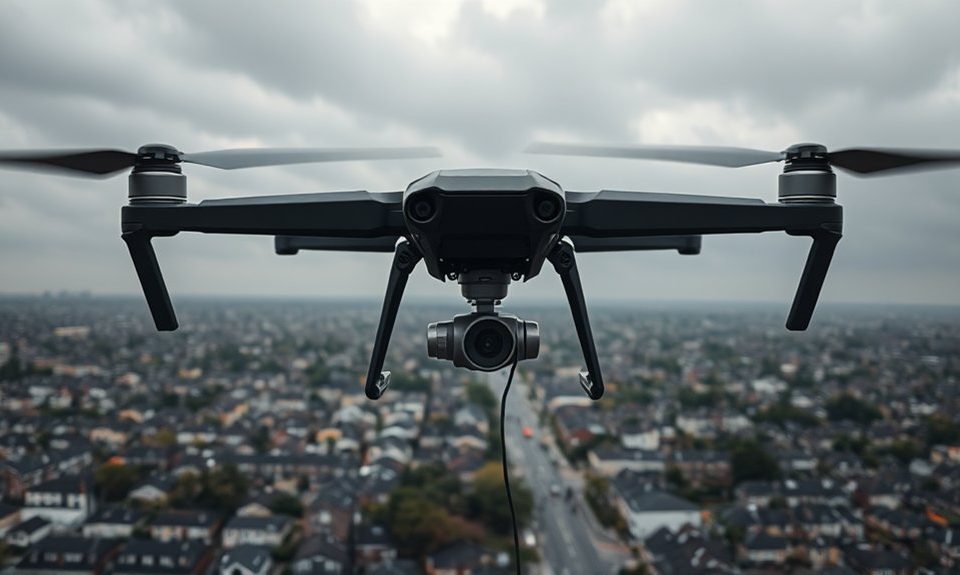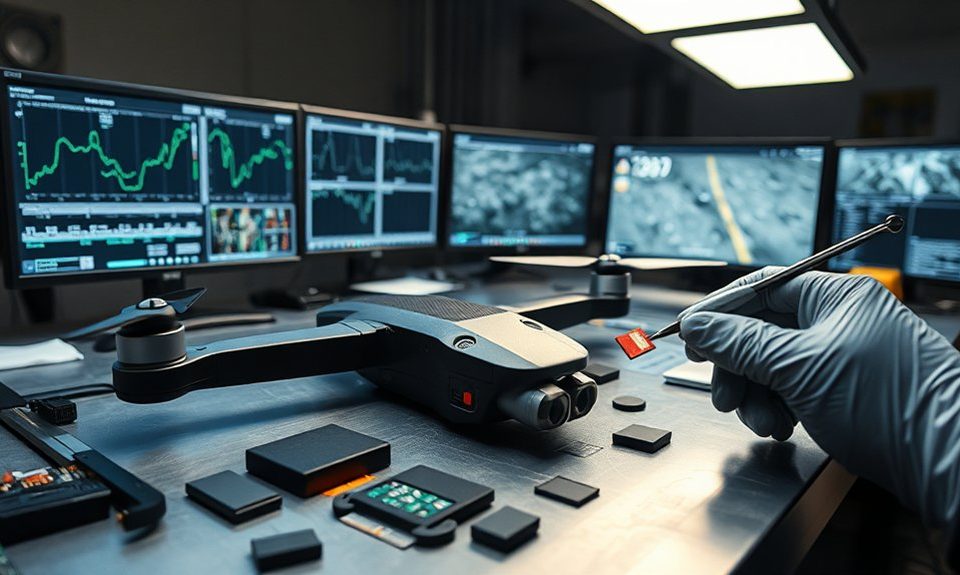Modern private investigators utilize a hybrid approach combining advanced digital technologies with traditional surveillance methods to locate missing persons. They employ AI-powered tools, social media intelligence systems (SOCMINT), and blockchain tracking while maintaining conventional fieldwork techniques. Investigators analyze digital footprints across multiple platforms, monitor cryptocurrency transactions, and deploy emerging technologies like drones and IoT devices. This all-encompassing strategy, backed by strict legal compliance and documentation, reveals the intricate methods required for successful missing persons investigations.
Key Takeaways
- Utilize AI-powered SOCMINT systems to analyze digital footprints across social media platforms, dating apps, and professional networks for recent activity patterns.
- Combine traditional surveillance methods with drone technology and satellite imaging to enhance physical search capabilities in public spaces.
- Monitor cryptocurrency transactions and blockchain ledgers to track financial activities that may reveal the subject’s whereabouts.
- Deploy integrated search strategies combining digital intelligence gathering with ground team operations for real-time response to leads.
- Extract and analyze data from IoT devices and digital forensics to reconstruct the subject’s last known activities and current location.
The Evolution of Traditional PI Methods in the Digital Era

While traditional private investigation methods once relied heavily on in-person surveillance and manual record searches, the digital revolution has transformed how PIs locate missing persons. Modern investigators now integrate time-tested missing person techniques with advanced digital tools, creating a hybrid approach that maximizes efficiency and success rates.
Today’s PIs utilize sophisticated database access, social media monitoring, and digital footprint analysis alongside conventional fieldwork. This evolution demands investigators maintain proficiency in both domains while maneuvering through complex ethical considerations. They must balance digital surveillance capabilities with privacy rights, ensuring compliance with current regulations while delivering results for their clients.
The synthesis of old and new methodologies enables investigators to cast a wider net, combining street-level intelligence gathering with powerful digital resources to locate missing individuals more effectively than ever before. Forensic techniques and facial recognition technology have become essential tools for gathering critical evidence in modern missing persons investigations.
Advanced Digital Tools and AI-Powered Search Techniques
Modern private investigators leverage sophisticated Social Media Intelligence (SOCMINT) systems to analyze patterns across multiple platforms and detect digital activities of missing persons. Advanced digital footprint analysis tools enable PIs to track online behaviors, including email communications, chat logs, and browsing histories that could reveal vital location data. These AI-powered technologies can process vast amounts of unstructured data from various digital sources, identifying connections and patterns that might otherwise remain undetected through traditional investigation methods. Professional investigators like Stillinger Investigations utilize latest covert systems to ensure the most comprehensive and court-admissible evidence gathering possible.
Social Media Intelligence Systems
Today’s private investigators leverage sophisticated Social Media Intelligence Systems (SOCMINT) to analyze digital footprints across multiple platforms simultaneously. These systems employ advanced social listening algorithms and metadata analysis to track patterns, relationships, and location data of missing persons.
| Platform Type | Data Collected | Investigation Value |
|---|---|---|
| Social Networks | Posts, Photos, Check-ins | Location History |
| Professional Sites | Work History, Connections | Employment Leads |
| Dating Apps | Recent Activity, Matches | Current Whereabouts |
| Forums/Blogs | Comments, Interests | Behavioral Patterns |
| Gaming Networks | Player Activity, Friends | Online Associations |
SOCMINT tools consolidate vast amounts of public data into actionable intelligence, enabling investigators to identify potential witnesses, track recent movements, and establish timelines. These systems often reveal significant connections that might otherwise remain hidden in the vast expanse of social media content.
Digital Footprint Analysis Tools
Beyond traditional social media monitoring, private investigators employ specialized digital footprint analysis tools that combine artificial intelligence with advanced data mining capabilities. These sophisticated platforms scan through vast amounts of missing data across multiple digital channels, creating extensive behavior patterns and location trajectories of individuals attempting online anonymity.
Modern digital footprint analysis leverages machine learning algorithms to process and correlate seemingly unrelated digital traces, including browser fingerprints, device identifiers, and timestamp patterns. The technology can identify relationships between various online personas, map frequent locations through IP addresses, and track digital payment footprints. These tools also analyze dark web activities, cached website data, and deleted online content, providing investigators with vital insights that may reveal a subject’s whereabouts or recent activities.
Social Media Intelligence and Online Footprint Analysis
Digital footprints scattered across social media platforms provide private investigators with invaluable intelligence for locating missing persons. Through advanced social media strategies and analysis of online behavior patterns, investigators can piece together essential information about a subject’s whereabouts, associations, and activities.
- Analysis of shared locations, check-ins, and geotagged photos across platforms reveals frequently visited places and travel patterns, helping narrow search parameters
- Examination of friend networks, group memberships, and online interactions exposes potential connections, witnesses, or individuals who may have relevant information
- Review of posting timestamps, activity patterns, and engagement habits provides insights into daily routines, preferred establishments, and lifestyle choices that could indicate current location
This systematic approach to social media intelligence gathering often yields vital leads that traditional investigative methods might miss.
Digital forensics combined with traditional investigative techniques enables investigators to build comprehensive profiles while maintaining strict legal compliance.
Blockchain and Cryptocurrency Tracking Strategies
While online footprints offer valuable intelligence through social media platforms, cryptocurrency transactions present private investigators with a distinct set of tracking opportunities. Modern investigators utilize specialized software to monitor blockchain ledgers, identifying patterns in digital currency movements that may reveal a missing person’s financial activities. The team’s technical surveillance equipment enhances their ability to gather digital evidence while maintaining ethical investigative practices.
Legal Compliance and Privacy Considerations in Modern Investigations

Modern private investigators must navigate complex data protection regulations that govern how personal information can be collected, stored, and used during missing persons investigations. The legal framework includes privacy laws like GDPR, CCPA, and federal statutes that establish strict boundaries around surveillance activities and information gathering methods. These regulations require investigators to maintain detailed documentation of their compliance efforts while protecting both the subject’s privacy rights and the client’s confidential information. Investigators must be particularly mindful when handling cases involving emotional infidelity, as digital communications and online interactions have created new challenges in defining privacy boundaries.
Data Protection Laws Today
Recent advances in data collection and surveillance have made privacy protection more critical than ever for private investigators. Modern data protection laws strictly govern how personal data can be collected, stored, and utilized during investigations. Private investigators must navigate complex privacy regulations while maintaining investigative effectiveness.
Key aspects of current data protection requirements include:
- Mandatory documentation of data collection methods and purpose, with clear audit trails for all accessed information
- Implementation of secure storage systems and encryption protocols to protect gathered personal data
- Regular privacy impact assessments and updates to data handling procedures to guarantee compliance with evolving regulations
Investigators who fail to comply with these requirements face significant penalties and potential license revocation. Understanding and adhering to data protection laws has become fundamental to conducting legitimate investigations in today’s privacy-conscious environment.
Surveillance Boundaries and Rights
Private investigators must operate within strict legal boundaries when conducting surveillance, as unauthorized monitoring can result in criminal charges and civil liability. When locating missing persons, PIs must balance surveillance ethics with investigative needs while respecting privacy rights.
| Activity | Legal Requirements | Privacy Considerations |
|---|---|---|
| Physical Surveillance | Public spaces only | No trespassing or stalking |
| Digital Monitoring | Written consent needed | Data protection compliance |
| Information Gathering | Legal documentation | Confidentiality agreements |
Understanding these boundaries guarantees investigations remain within acceptable parameters. Investigators must obtain proper authorization before accessing private property, monitoring electronic communications, or gathering personal information. They should document all surveillance activities, maintain clear records of consent, and immediately cease any monitoring if requested by the subject. This approach protects both the investigator and the subject’s legal rights.
Emerging Technologies: Drones, Satellites, and IoT Devices

Technological advancements have revolutionized how investigators conduct missing persons searches, with drones, satellites, and Internet of Things (IoT) devices becoming essential tools in the field. Modern drone capabilities enable investigators to survey large areas quickly, access difficult terrain, and capture high-resolution imagery in real-time.
- Satellite imaging provides exhaustive geographical data, thermal mapping, and historical location information that helps track movement patterns and identify potential search areas.
- IoT applications, including smart devices and sensors, create digital footprints that investigators can analyze to reconstruct a missing person’s last known activities.
- Aerial surveillance through drones equipped with infrared cameras and GPS tracking systems allows investigators to conduct searches during both day and night, increasing the chances of successful recovery.
These technologies, when used together, notably enhance the efficiency and effectiveness of missing persons investigations. Professional investigators can complement these tools with digital forensics examinations to extract crucial evidence from recovered devices within approximately 8 hours.
Building a Comprehensive Search Strategy: Digital and Physical Integration
A successful missing persons investigation requires seamless integration of digital intelligence and physical search operations. Private investigators now develop extensive strategies that merge online data mining with traditional fieldwork, creating a more complete investigative picture. They establish collaborative networks with local law enforcement, community organizations, and digital forensics experts to expand their reach.
The modern search approach coordinates real-time digital surveillance with strategic physical presence. Investigators simultaneously monitor social media activity, analyze electronic footprints, and conduct ground searches while engaging in community outreach. This dual-channel methodology allows investigators to quickly verify digital leads through physical confirmation and vice versa. When digital signals indicate a potential location, ground teams can immediately respond, while field observations can prompt targeted online searches, creating a dynamic and responsive investigation process. With advanced surveillance tools and over 50 years of combined experience, Stillinger Investigations demonstrates how modern technology and traditional expertise work together to resolve complex missing persons cases.
Frequently Asked Questions
What Is the Average Cost of Hiring a PI for Missing Persons Cases?
Private investigators typically charge average fees between $50-150 per hour for missing persons cases, with total investigative expenses ranging from $1,500-5,000 depending on case complexity and duration.
How Long Does a Typical Missing Person Investigation Usually Take?
Missing person investigation timelines typically range from several days to multiple months, depending on case complexity, available leads, and circumstances surrounding the disappearance. Each case presents unique investigative challenges and variables.
Do Private Investigators Work With Law Enforcement on Missing Persons Cases?
Private investigators frequently collaborate with law enforcement agencies, sharing information and resources through established investigative procedures. This partnership benefits missing persons cases by combining professional expertise and jurisdictional access.
What Is the Success Rate of Finding Missing Persons Through Private Investigators?
Success rates for private investigators vary considerably, with case studies indicating 50-75% resolution rates. Success factors include case timeline, available resources, client cooperation, and investigator expertise in missing persons cases.
Can PIS Search for Missing Persons in Foreign Countries or Across Borders?
Private investigators can conduct international investigations across borders through established networks, local contacts, and cross-border techniques. However, they must comply with each country’s laws and jurisdictional requirements when searching.
Conclusion
As investigative methods continue to evolve, successful missing persons investigations in 2025 will require a balanced approach combining traditional techniques with cutting-edge technology. Private investigators must stay current with digital forensics, AI analytics, and emerging tools while maintaining strict legal compliance. The integration of physical surveillance, social media intelligence, and advanced tracking technologies remains essential for achieving ideal results in modern missing persons cases.





